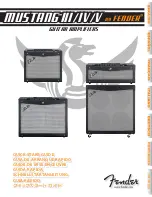
10
| JL Audio - XD400/4v2 Owner’s Manual
Note: When the “Input Voltage” switch is in its
“Low” position, the level of the “Preouts” signals
matches the input signal levels (unity gain). When
the “Input Level” switch is in the “high” position,
the level of the input signal is attenuated –12 dB
to produce a line level signal at the “Preouts”.
This ensures a proper line level signal output
under both conditions.
If you plan to use the “Preouts” to feed a stereo
amplifier, you must connect a stereo signal to
the input of the amplifier. A mono signal into
the amplifier will result in a mono signal out of
the preamp output.
SPEAKER OUTPUTS
The XD400/4v2’s speaker outputs are designed
to accept 16 AWG - 8 AWG wire. To connect the
speaker wires to the amplifier, first back out the
set screws on the top of the terminal block, using
the supplied 2.5 mm hex wrench. Strip 1/2 inch
(12 mm) of insulation from the end of each wire
and insert the bare wire into the terminal block,
seating it firmly so that no bare wire is exposed.
While holding the wire in place, tighten the set
screw firmly, taking care not to strip the head of
the screw.
Each pair of the XD400/4v2’s channels
are designed to deliver power into speaker
loads equal to or greater than 2 ohms when
using a “stereo” configuration and speaker
loads equal to or greater than 4 ohms
when using a “bridged” configuration.
Speaker loads below 2 ohms nominal per
channel (or 4 ohms bridged) are not
recommended and may cause the amplifier
to initiate a protection mode which reduces
power output.
BRIDGING CONSIDERATIONS
Bridging is the practice of combining the
output of two amplifier channels to drive a single
load. When bridged, each channel produces
signals of equal magnitude, but opposite polarity.
The combined output of the two channels
provides twice the output voltage available from a
single channel. The XD400/4v2 has been designed
for bridging of its main channel pairs without the
need for input inversion adaptors.
To bridge a pair of main channels, use the
“Left +” and “Right –”speaker connectors only
(the “Left –” and “Right +” remain unused). Each
bridged channel pair will deliver optimum power
into a 4 ohm load.
When a pair of the XD400/4v2’s channels are
bridged, they will deliver 200W x 1 into a 4 ohm
load or 150W x 1 into an 8 ohm load. Operating
a pair of bridged channels into a load lower than
4 ohms is not recommended.
A bridged pair of channels requires that
both channels in the pair receive input. You
must connect the mono or stereo source signal
to both the left and right inputs of the bridged
channel pair. Connection of only one input
will result in reduced power output, increased
distortion and can cause the amplifier to
overheat. Do not do this!
When a pair of the XD400/4v2’s channels are
operating in bridged mode, the output will be in
mono (only one channel). This mono channel can
contain only right channel information, only left
channel information, or the sum of the signals
from right and left input channels. In order to
achieve one of these options, configure the inputs
to that pair of channels in one of these two ways:
1) Left Channel Only or Right Channel Only
Information: If you wish to send a left-only or
right-only signal to a pair of the XD400/4v2’s
channels you must use a “Y-Adaptor” to split
the single channel signal into both left and
right RCA inputs of the bridged channel
pair. This option is used when deploying a
Summary of Contents for XD 400/4v2
Page 19: ...19...






































